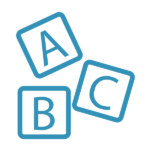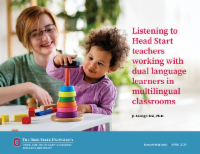Author: Dr. Ji-Young Choi
About the brief
Dual language learners (DLLs) – children from birth to age five who simultaneously develop language skills in their home language as well as English – are a growing population. In Ohio, DLLs comprise 13% of children from birth to age five, with over 90 languages used by students in preschool through grade twelve. Nationally, one in three children live in a home with a language other than English spoken.
This research brief by Dr. Ji-Young Choi shares findings from a study capturing teacher insights on their roles in supporting DLLs’ learning. To learn more about DLL education – particularly insights from multilingual preschool-aged Head Start classrooms – teachers were surveyed and interviewed about their unique beliefs, teaching practices, and needs. Researchers also observed the classrooms under study.
Several key findings emerged:

While teachers in the study did use instructional strategies for DLLs, they felt unprepared to teach these students effectively.

Teachers felt comfortable teaching DLLs when they had support; support could be offered in the form of translation programs, bilingual colleagues, or mentors.

Teachers often used different instructional practices for DLLs, such as repetitions, bilingual labeling, and individual interactions.

Teachers believed in the importance of fostering the home language of DLLs; however, many reported that parents may prioritize children’s English-language learning.



